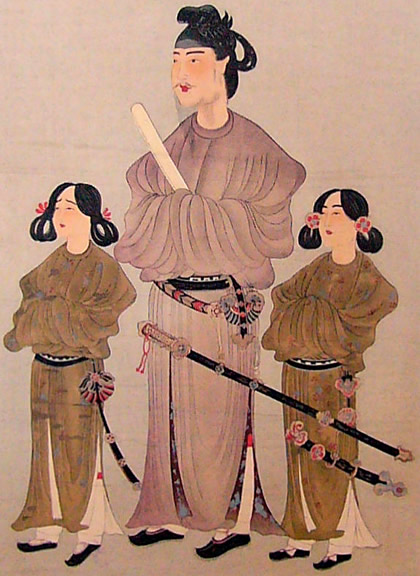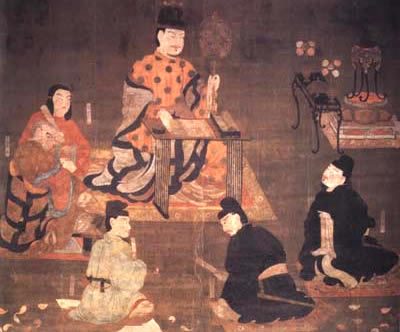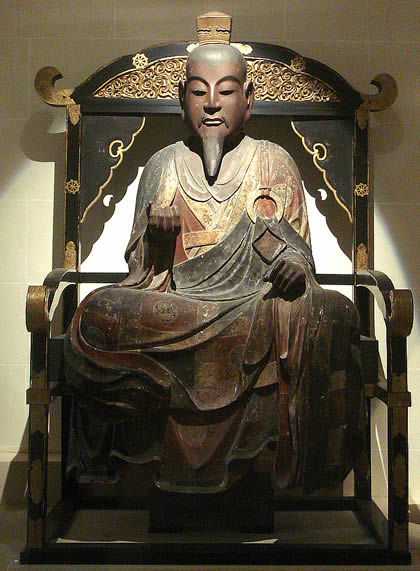 |
| Prince Shotoku Taishi |
Prince Shotoku Taishi was crown prince and regent of Japan between 592 and 622. His rule opened an masa of great reforms that advanced Buddhism and Chinese political and cultural influence in Japan. For his role he is called the Great Civilizer.
Up to the sixth century Chinese cultural influence had grown gradually in Japan. After the mid-sixth century the process quickened. One reason was the gradual strength and reach of the Yamato state, which required more complex institutions than the clan government of Japan had provided.
Second, China became unified in 589 under the Sui dynasty after three and half centuries of division. The great Tang (T’ang) dynasty followed, one of the greatest in China’s imperial history and worthy of emulation. The third factor was the introduction of Buddhism to Japan from China via Korea (the southern Korean state Paekche had a very close relationship with Japan) in 552.
 |
Buddhism was attractive to many Japanese but was also resented because it was foreign and not associated with Japanese mythology and the shamanistic practices of its native Shintoism.
In 587 the Soga clan won ascendancy at the Yamato court; the chief’s niece, Suiko, became empress, and her nephew Shotoku, descended from both the imperial and Soga clans, became her regent. Shotoku began a great masa of reforms that would advance Japanese civilization in the pattern of China.
 |
| Shotoku court |
He was a devout Buddhist; in fact a legend has him clutching a statuette of the Buddha at his birth. He proclaimed Buddhism the preferred state religion, promoted the building of temples, welcomed monks and missionaries from China and Korea, lectured on Buddhist teachings, and wrote commentaries on three Buddhist sutras.
Thus Buddhism became the most important vehicle for the advancement of Chinese culture. However Buddhism did not provide a structure for the organization of government and society, and for those he turned to the imperial structure of China of the Sui-Tang dynasties.
In 604 Prince Shotoku promulgated the Seventeen Article Constitution (or Injunctions). Article II promoted Buddhism stating: “Sincerely revere the three treasures, viz. Buddha, the Law and the Priesthood, are the simpulan refuge of the four generated beings, and are the supreme object of faith in all countries.
Any person of any age should revere Buddhist law. Few persons are really bad. If they are taught well, they will be obedient. But if they are not converted [to the truth of] the Three Treasures, how can their wrongs be corrected?”
The other 16 articles promoted Confucian precepts such as the supremacy of the ruler, a centralized government, a bureaucracy based on merit and correct principles, and social relationships that promoted harmony. In the same year Prince Shotoku also adopted the Chinese calendar, thereby accepting the Chinese view of world order.
China required its tributary states to adopt the Chinese calendar as sign of vassalage. Japan adopted it voluntarily and did not become a Chinese vassal state. He also adopted major features of a Chinese style bureaucratic rule and system of court ranks for officials.
 |
| Shotoku wood statue |
In 607 Shotoku broke new ground by sending an official embassy to the Chinese court. He would send a total of three, the two subsequent ones in 608 and 614, but the embassies would continue until the mid-ninth century, long after Shotoku’s reign had ended.
Each of the later ones had a contingent of four ships with between 500 and 600 students, some staying in China for up to 10 years. After returning to Japan the students, including government officials, monks, musicians, painters, and scholars, became transmitters of what they had learned to the wider society.
His initiative resulted in one of the greatest technology transfers in premodern times. In addition to government-sponsored students, private individuals also began to travel to China to study, and trade also increased between the two countries. Educated Japanese read Chinese books and wrote in Chinese.
The common written script came to unite Chinese, Koreans, and Japanese in a common literary heritage and a shared tabiat and historical tradition. Many Chinese and Koreans immigrated to Japan during this period, which accelerated the spread of Chinese culture.
The Soga clan continued to dominate the Japanese court after Shotoku’s death. His opponents had feared that he sought the throne. But his son Prince Yamashiro refused to press his candidacy for the throne when Empress Suiko died in 628.
In 645 the Soga clan was defeated and lost its influence at court. However Prince Shotoku’s legacy continued, and even accelerated, during the next century as Japan continued to catapult forward in adopting Chinese culture and institutions.
EmoticonEmoticon